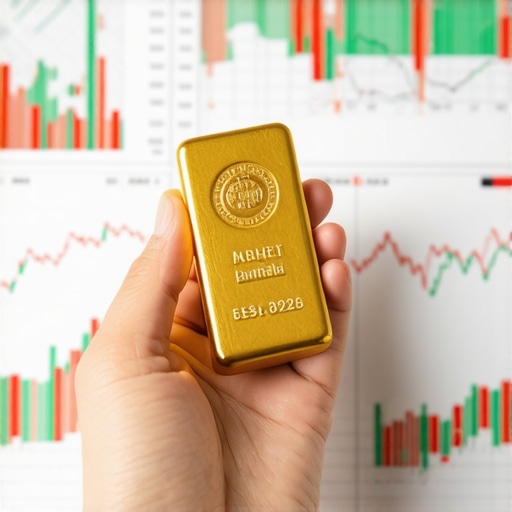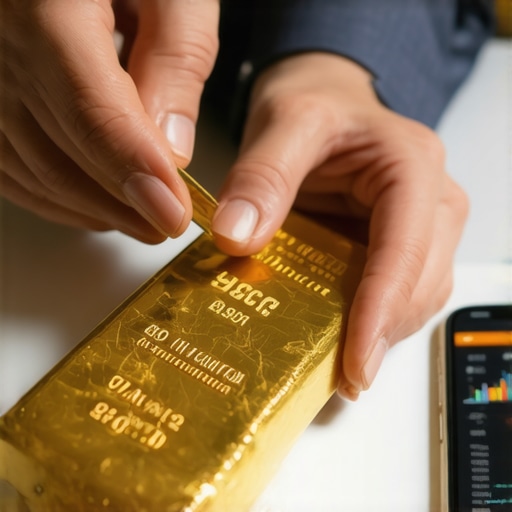Unlocking the Golden Door: Why Safety is Paramount in Buying Gold Bars and Coins
Investing in gold bars and coins is a timeless strategy to preserve wealth and hedge against market volatility. However, for beginners, the allure of physical gold can be clouded by fears of fraud, counterfeit products, and poor storage practices. Understanding how to navigate this landscape safely is essential to protect your investment and ensure peace of mind. This guide offers expert insights on buying gold bars and coins safely, weaving practical tips with nuanced understanding that seasoned investors rely on.
Decoding Authenticity: Spotting Genuine Gold Bars and Coins with Confidence
Authenticity is the cornerstone of safe gold investment. Genuine gold bars and coins carry specific hallmarks—such as purity stamps, manufacturer logos, and serial numbers—that distinguish them from counterfeits. For instance, reputable mints like the Perth Mint or the Royal Canadian Mint provide certificates of authenticity alongside their bullion products. Utilizing tools such as electronic gold testers or even ultrasonic devices can help verify purity levels before purchase. Remember, buying from established dealers reduces the risk of encountering fakes compared to unknown sources.
How Can Beginners Avoid Common Pitfalls When Purchasing Gold Bars and Coins?
New investors often fall prey to inflated premiums, scams, or purchasing gold that is not easily liquidated. To avoid these pitfalls, start by researching the dealer’s reputation through reviews and certifications from organizations like the Professional Numismatists Guild. Be wary of deals that seem too good to be true; extremely low prices often signal counterfeit or stolen goods. Additionally, understanding market premiums—extra costs above the spot price—helps prevent overpaying. For example, smaller coins typically carry higher premiums due to their craftsmanship and demand. Always request a detailed invoice and ensure proper documentation.
Secure Storage Solutions: Protecting Your Physical Gold from Risks
Owning physical gold mandates careful consideration of storage. While keeping gold at home might seem convenient, it exposes the asset to theft or damage. Instead, secure vault storage or safety deposit boxes offer robust protection. Some investors opt for professional bullion storage services that provide insured, climate-controlled environments. These choices not only safeguard the gold but also enhance liquidity by offering easy access for resale. Understanding your storage options aligns with your risk tolerance and investment goals.
Leveraging Market Knowledge: Strategic Timing and Purchasing Channels
Timing purchases can influence the safety and profitability of gold investments. Monitoring global economic signals, geopolitical tensions, and central bank gold purchases can inform smarter buying decisions. For instance, during market uncertainty, gold demand often spikes, affecting prices and availability. Trusted online platforms and authorized dealers provide transparency and competitive pricing. Engaging with resources like the Physical Gold Investment: Safely Buying Gold Coins and Bars guide can deepen your understanding of secure purchasing channels.
Call to Action
If you found these insights valuable, consider sharing this guide with fellow investors or leaving a comment below with your own experiences. Your engagement helps build a community of informed gold investors.
Authoritative Reference: For a comprehensive exploration of gold investment safety, consult the World Gold Council’s detailed reports on bullion authenticity and market integrity at Gold Hub Research, a premier resource trusted by experts worldwide.
Personal Lessons on Navigating Gold Market Volatility
Reflecting on my journey investing in physical gold, I’ve realized that understanding market cycles is just as important as verifying authenticity. During periods of economic uncertainty, such as recessions or geopolitical unrest, gold prices tend to surge. However, these times also attract fraudsters aiming to exploit inexperienced buyers. That’s why I always keep myself informed through reliable sources and maintain a cautious approach when prices fluctuate dramatically.
One technique I found invaluable is following central bank gold buying trends. For instance, the recent surge in gold purchases by nations like China and Russia has underscored gold’s strategic importance globally. According to a recent World Gold Council report, central banks’ activities significantly influence global gold prices and liquidity. Keeping an eye on such developments helped me time some of my purchases more wisely.
Making Smart Choices: Physical Gold vs. Gold ETFs and Stocks
While I cherish the tangible security of physical gold bars and coins, I also diversified by exploring gold ETFs and stocks. Each has its pros and cons. Physical gold offers direct ownership and a hedge against inflation but requires secure storage and insurance. Meanwhile, gold ETFs provide liquidity and ease of trading without physical custody, though they lack the emotional reassurance physical gold offers.
If you’re curious about which option might suit your financial goals, I recommend exploring detailed comparisons like the one offered in our guide on Gold ETFs vs Physical Gold. It helped me understand how to balance my portfolio to mitigate risks while maximizing growth potential.
What Questions Should You Ask Before Buying Your First Gold Investment?
When I started, I asked myself several key questions that helped clarify my strategy. How much am I willing to invest upfront? What level of liquidity do I need? Do I have a secure place to store physical gold? Am I prepared to hold long-term to weather price swings, or am I looking for quicker gains? These reflections shaped my approach and prevented costly mistakes.
Moreover, seeking advice from trusted dealers and reviewing certifications before any purchase became a non-negotiable step. It’s also wise to read testimonials and check for membership in reputable industry groups like the Professional Numismatists Guild. This diligence has saved me from several potential scams and counterfeit deals.
Practical Tips for Safe Gold Storage That I Swear By
Beyond buying, protecting your gold is paramount. I personally use a combination of a high-quality home safe and a professional vault storage service. The vault provider I chose offers insurance and climate control, which gives me peace of mind that my investment is secure from theft and environmental damage.
If you’re considering storage options, you might find our Quick Guide to Physical Gold Storage and Security Tips useful. It covers everything from home safes to third-party storage solutions and their respective risks and benefits.
Remember, the best storage solution matches your personal risk tolerance, budget, and convenience needs. For example, while home safes offer immediate access, they require robust security measures and insurance. On the other hand, professional vaults add a layer of security but might incur storage fees and accessibility delays.
How Do You Stay Informed and Confident in Your Gold Investments?
Staying informed is an ongoing process. I subscribe to newsletters from the World Gold Council and follow market analysis from trusted financial media. Engaging with experienced investors in forums and communities has also enriched my perspective.
Have you found any resources or strategies particularly helpful in your gold investment journey? Sharing your experiences can foster a richer understanding for everyone involved. Feel free to comment below or explore more insights on effective gold investment strategies for inflation protection and long-term wealth growth through resources like this guide.
Call to Action
If this article resonated with you, please share it with friends or fellow investors. Your stories and questions in the comments help build a knowledgeable community where we all grow together in mastering the art of safe gold investment.
Innovative Techniques for Authenticity Verification: Beyond Traditional Hallmarks
While hallmark stamps and certificates remain the baseline for authenticating gold bars and coins, seasoned investors employ more sophisticated verification methods to protect their holdings. Techniques such as X-ray fluorescence (XRF) spectrometry enable non-destructive elemental analysis, providing precise purity readings and detecting potential alloy substitutions. Similarly, laser ablation inductively coupled plasma mass spectrometry (LA-ICP-MS) offers in-depth compositional profiling, revealing subtle differences in trace elements that counterfeiters often overlook.
These advanced technologies are increasingly accessible through specialized assay services and high-end portable devices, empowering investors to conduct on-the-spot verification during transactions. Coupled with blockchain-based provenance tracking, which records the entire lifecycle of a gold asset from mine to market, these innovations significantly reduce risks associated with fraud and provenance disputes.
How Can Blockchain Technology Revolutionize Gold Bar and Coin Authentication?
Blockchain technology introduces a tamper-proof digital ledger that can document every transaction and ownership transfer of physical gold. By embedding unique identifiers and linking them to blockchain entries, each gold bar or coin gains a verifiable digital fingerprint. This system enhances transparency and trust, as buyers can independently verify authenticity and history without relying solely on paper certificates or dealer assurances.
Leading industry players are piloting blockchain platforms specifically designed for precious metals, integrating smart contracts that automate compliance and facilitate secure, instantaneous settlements. The World Gold Council has acknowledged the potential of such technologies to transform bullion markets, emphasizing their role in enhancing liquidity and investor confidence (World Gold Council on Blockchain and Gold).
Mastering Risk Mitigation: Tailored Insurance and Diversified Storage Solutions for Physical Gold
Investors often underestimate the nuanced interplay between storage security and insurance coverage. An optimal approach involves a dynamic risk assessment tailored to individual investment scale, geographic location, and threat landscape. For instance, insuring a home-stored gold collection demands comprehensive policies that cover theft, natural disasters, and even loss due to human error.
Conversely, segregated vault storage with insured third-party custodians offers superior risk mitigation and can enhance asset liquidity. Some premium vault services provide multi-jurisdictional custody options, allowing investors to diversify geopolitical risk by storing assets across different countries. This strategy is particularly relevant amid rising concerns about regulatory changes or political instability affecting physical gold ownership.
Engaging with insurance experts who specialize in precious metals can ensure that coverage limits, deductibles, and policy terms align precisely with your investment profile, minimizing unexpected exposure.
Market Timing Revisited: Leveraging Algorithmic Analysis and Geopolitical Indicators for Strategic Gold Purchases
Beyond monitoring traditional economic indicators, advanced investors integrate algorithmic models and geopolitical intelligence to fine-tune their gold acquisition timing. Machine learning algorithms analyze historical price patterns, macroeconomic data, and sentiment trends to forecast price movements with increasing accuracy. This data-driven approach complements qualitative analysis of geopolitical events such as trade disputes, central bank interventions, and currency fluctuations.
In practice, this means an investor might anticipate a gold price surge by identifying converging indicators: for example, escalating inflation expectations combined with central bank asset purchases and rising geopolitical tensions. Such insights enable not only safer entry points but also the optimization of portfolio allocation between physical gold and related financial instruments.
What Role Do Central Banks’ Gold Reserves Play in Shaping Global Market Dynamics?
Central banks are pivotal market participants whose gold reserve policies signal broader economic strategies. Accumulation trends often reflect efforts to diversify foreign exchange reserves, hedge against currency risks, or project financial stability. Conversely, selling or leasing gold can indicate liquidity needs or shifts in monetary policy.
Tracking central banks’ quarterly reports and announcements provides investors with actionable intelligence. For example, the International Monetary Fund’s COFER (Currency Composition of Official Foreign Exchange Reserves) database offers detailed statistics on reserve compositions, enabling sophisticated analysis of global gold demand drivers.
Call to Action
Elevate your gold investment strategy by exploring these advanced verification and risk management techniques. Dive deeper into blockchain applications and insurance frameworks to secure your assets effectively. Share your experiences with cutting-edge gold authentication tools or innovative storage solutions in the comments below—your insights contribute to a thriving community of expert investors.
Harnessing Cutting-Edge Forensic Techniques to Authenticate Gold
Beyond conventional hallmark verification, forensic metallurgy has emerged as a vital tool for discerning genuine gold bars and coins. Techniques like scanning electron microscopy (SEM) and energy dispersive X-ray spectroscopy (EDX) provide granular insights into microstructural characteristics and elemental composition that counterfeiters struggle to replicate accurately. These analyses not only confirm purity but also detect subtle anomalies indicative of manufacturing inconsistencies or tampering.
Integrating these scientific methods with provenance data enhances the reliability of authenticity assessments, especially for high-value acquisitions where due diligence must be uncompromising.
How Do Emerging Sensor Technologies Enhance Real-Time Gold Verification During Transactions?
Recent innovations in sensor technology, such as portable Raman spectroscopy and near-infrared (NIR) spectroscopy devices, are revolutionizing in-field gold verification. These non-invasive instruments enable investors and dealers to perform immediate compositional analysis without damaging the asset, facilitating swift and confident transactions even in secondary markets or private sales.
By leveraging machine learning algorithms embedded within device software, these tools can compare spectral signatures against extensive databases, flagging discrepancies that warrant further investigation. This real-time verification significantly lowers the risk of fraud and elevates market transparency.
Unlocking the Potential of Tokenized Gold Investments in the Digital Economy
Tokenization represents an innovative frontier marrying physical gold ownership with blockchain technology. By creating digital tokens backed by allocated physical gold stored in insured vaults, investors gain fractional ownership with enhanced liquidity and accessibility. This paradigm reduces entry barriers by allowing smaller investment increments and simplifies transferability through decentralized exchanges.
Moreover, tokenized gold can be integrated into decentralized finance (DeFi) platforms, enabling users to leverage gold-backed assets as collateral or earn yield via staking mechanisms. While regulatory frameworks continue to evolve, this fusion of tangible assets with digital finance promises to democratize gold investment and introduce unprecedented flexibility.
Comprehensive Risk Hedging: Multi-Jurisdictional Storage and Legal Safeguards
For high-net-worth individuals and institutional investors, distributing physical gold holdings across multiple jurisdictions serves as a sophisticated risk mitigation strategy. This approach minimizes exposure to localized political upheaval, legal restrictions, or confiscation risks. Selecting vault providers with robust regulatory compliance and transparent operational protocols is critical.
Additionally, implementing legal instruments such as trusts or custodial agreements tailored for precious metals ownership can provide enhanced protection and facilitate seamless succession planning. Collaborating with legal experts specializing in asset protection ensures that these frameworks align with international standards and personal estate objectives.
Algorithmic Intelligence Meets Geopolitical Expertise: Predictive Analytics in Gold Market Timing
State-of-the-art algorithmic platforms now combine quantitative financial modeling with qualitative geopolitical intelligence to forecast gold price movements. These systems ingest vast datasets encompassing currency fluctuations, inflation metrics, trade tensions, and central bank activities to generate probabilistic scenarios aiding strategic entry and exit decisions.
Investors utilizing these predictive analytics can dynamically adjust portfolio allocations, optimizing for risk-adjusted returns while anticipating market shocks. This fusion of data science and geopolitical analysis represents a paradigm shift from intuition-based to evidence-driven gold investing.
What Are the Implications of Central Banks’ Strategic Gold Reserves Management on Private Investment Portfolios?
Central banks’ strategic management of gold reserves profoundly influences global liquidity and price stability. Their acquisition or divestiture decisions often preempt macroeconomic shifts and signal monetary policy directions. Private investors attuned to these trends can capitalize on anticipatory market movements by aligning their holdings accordingly.
For instance, increases in central bank gold purchases, as documented in the IMF’s COFER database, frequently coincide with currency devaluations or rising inflation expectations, underscoring gold’s role as a safe haven. Conversely, unexpected reserve sales may presage market corrections, advising caution.
Call to Action
Elevate your gold investment acumen by embracing these advanced authentication technologies, digital tokenization innovations, and sophisticated risk management tactics. Engage with our community by sharing your experiences or inquiries about implementing these cutting-edge strategies. Together, we can pioneer a new era of secure, transparent, and dynamic gold investing.
Frequently Asked Questions (FAQ)
What are the most reliable methods to verify the authenticity of gold bars and coins?
Beyond traditional hallmarks and certificates, advanced techniques such as X-ray fluorescence (XRF) spectrometry, laser ablation inductively coupled plasma mass spectrometry (LA-ICP-MS), and forensic metallurgy methods like scanning electron microscopy (SEM) provide precise and non-destructive verification of purity and composition. Additionally, blockchain-based provenance tracking is emerging as a powerful tool to ensure authenticity and traceability from mine to market.
How does blockchain technology enhance security and trust in gold investments?
Blockchain creates a tamper-proof digital ledger recording every transaction and ownership transfer of physical gold assets. By linking unique identifiers of gold bars or coins to blockchain entries, investors gain transparent, independently verifiable proof of authenticity and provenance, reducing reliance on paper certificates and mitigating fraud risks.
What storage options best balance security, accessibility, and cost for physical gold?
Storage solutions range from high-quality home safes with insurance to professional bullion vaults offering insured, climate-controlled environments. Professional vaults provide superior security and liquidity but may involve storage fees and access delays. Multi-jurisdictional storage further mitigates geopolitical risks. The optimal choice depends on your investment size, risk tolerance, and convenience needs.
How do central banks’ gold reserve activities impact private gold investors?
Central banks’ buying or selling of gold reserves significantly influences global gold prices and liquidity. Accumulation often signals diversification and hedging strategies, potentially driving prices upward, while sales may indicate liquidity needs and price corrections. Monitoring central bank reports and databases like the IMF’s COFER enables investors to anticipate market trends and adjust their portfolios strategically.
What are the advantages and risks of investing in tokenized gold compared to physical gold?
Tokenized gold offers fractional ownership with enhanced liquidity and ease of transfer through blockchain platforms, lowering entry barriers and enabling integration with decentralized finance (DeFi) applications. However, it relies on digital infrastructure and regulatory frameworks that are still evolving, and does not provide direct physical possession, which some investors prefer for security and emotional reassurance.
How can algorithmic and geopolitical analysis improve timing in gold purchases?
Combining machine learning algorithms analyzing historical price data and macroeconomic indicators with qualitative geopolitical intelligence allows investors to forecast price movements more accurately. Identifying converging signals—such as inflation trends, central bank interventions, and geopolitical tensions—helps optimize entry points and portfolio allocations, enhancing risk-adjusted returns.
What insurance considerations should be made when storing physical gold?
Insurance policies must be tailored to cover theft, natural disasters, and loss scenarios specific to the storage method chosen. Home storage demands comprehensive coverage including burglary and damage, while professional vaults often include insurance but require due diligence on coverage limits and terms. Consulting with specialists in precious metals insurance ensures alignment with investment value and risk profile.
Are smaller gold coins always more expensive relative to their spot price?
Smaller gold coins generally carry higher premiums due to increased manufacturing costs, design intricacies, and demand. While this can reduce immediate cost efficiency, smaller denominations offer greater liquidity and flexibility for diversification and selling in increments, which can be advantageous depending on investment strategy.
How can investors protect their gold holdings against geopolitical and regulatory risks?
Diversifying storage across multiple jurisdictions with compliant, reputable vault providers reduces exposure to localized political instability or confiscatory actions. Legal instruments such as trusts or custodial agreements tailored for precious metals ownership further enhance protection and facilitate estate planning, ensuring continuity and security of assets.
What key questions should a beginner ask before investing in physical gold?
Fundamental questions include: What is my investment horizon? How much liquidity do I require? Do I have secure storage options? What level of authenticity verification do I need? Am I prepared for potential price volatility? Addressing these helps shape a sound, personalized investment plan and mitigates common pitfalls.
Trusted External Sources
- World Gold Council (gold.org): An authoritative resource offering comprehensive research, market data, and insights on gold investment, authenticity standards, and emerging technologies like blockchain integration.
- International Monetary Fund (IMF) COFER Database (imf.org): Provides detailed data on the currency composition of official foreign exchange reserves, crucial for analyzing central banks’ gold reserve strategies and global market impacts.
- Professional Numismatists Guild (PNG): A leading industry body ensuring dealer credibility, ethical standards, and education on numismatic and bullion products, invaluable for verifying trusted sellers.
- Journal of Materials Science & Metallurgy: Offers peer-reviewed studies on forensic metallurgy techniques applicable to gold authentication, enabling deeper scientific understanding of purity verification.
- Financial Times and Bloomberg Precious Metals Sections: Provide up-to-date market analysis, geopolitical developments, and algorithmic trading insights relevant to strategic gold investment timing.
Conclusion
Investing safely in gold bars and coins demands a multifaceted approach that marries traditional verification methods with cutting-edge technologies like forensic metallurgy and blockchain-based provenance tracking. Strategic storage solutions, tailored insurance, and informed market timing—enhanced by algorithmic and geopolitical analysis—further fortify your position against the inherent risks of physical gold ownership. Monitoring central bank activities and embracing innovations like tokenized gold can diversify your portfolio and increase flexibility. By asking the right questions, verifying sources, and adopting expert-validated techniques, investors can confidently navigate the complexities of the gold market. We encourage you to apply these insights, share your experiences, and explore additional expert content to master the art of secure and profitable gold investment.











This guide offers a fantastic overview of how to approach buying gold bars and coins safely, especially for beginners. I particularly appreciated the insights about verifying authenticity—while hallmark stamps and certificates are important, incorporating tools like electronic testers definitely adds another layer of security. From my experience, purchasing from reputable dealers and insisting on full documentation can truly save you from potential scams. Additionally, the advice on storage resonated with me. I initially stored a small collection at home, but after reading about professional vault services and their insured, climate-controlled environments, I decided to transition for peace of mind. One challenge that I’ve noticed is balancing the desire for quick access to physical gold against the security trade-offs of home storage versus vaults. It would be interesting to hear from others: how do you weigh convenience versus security when choosing your storage solution? Also, with the rise of technologies like blockchain and portable assay devices mentioned in the article, has anyone started using these for verification in real transactions? I’m curious about their practicality and impact on the market.
This article provides valuable insights into the importance of ensuring safety and authenticity when investing in physical gold. I’ve found that one aspect often overlooked by beginners is the significance of understanding the provenance of their gold. Some newer technologies, like blockchain-based tracking, are making it easier to verify a gold item’s history, which not only adds confidence but also helps prevent issues related to stolen or stolen-related articles entering the market. I personally use a combination of trusting well-known mints and periodically verifying using portable spectrometry devices, which provide real-time analysis without damaging the product. However, I wonder how prevalent these advanced verification tools are among average investors now. Are they becoming standard practice, or are they still mainly tools for elite or institutional players? From your experience or research, what steps can smaller or individual investors take to incorporate these technologies without significant costs? I believe that as these tech solutions become more accessible, it could dramatically improve the overall safety and transparency of gold trading.
This article highlights some critical points about purchasing gold safely, especially for beginners. I agree that verifying authenticity is essential, and I’ve personally used ultrasonic devices to check gold purity before buying. What I found interesting is the emphasis on storage options; I started with a home safe but soon realized the risks involved, leading me to opt for a professional vault. The challenge remains in balancing accessibility with security. Has anyone here experimented with newer verification technologies like portable XRF analyzers or blockchain tracking? I believe these innovations are making gold investment safer, but their accessibility for individual investors is still limited. It might be worthwhile to explore cost-effective options or community-based verification practices. Also, what are your thoughts on diversifying storage geographically to mitigate local risks? Overall, staying informed with reliable sources and adopting technology seems to be the best approach for safeguarding investments.